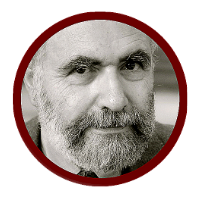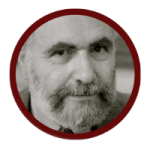In the Middle East, the main victims were Christians and Jews.
Bshara Nassar – a self-described « peacebuilder and social entrepreneur, a graduate of Bethlehem University, Palestine », with « a master's degree in Conflict Transformation from Eastern Mennonite University » – leads a campaign for a « Nakba Museum Project of Memory and Hope » in order to « bring the Palestinian refugee story to Washington, DC ».
The campaign, supported by Nonviolence International With Nakba Museum and Indiegogo, a crowd-funding organization, was launched in 2014 and seems to enjoy
Crime, including political crime and politically or militarily motivated mass murder, is usually a mean to achieve some higher purpose or to bring about some practical benefit. For instance, the Ottoman rationale in 1915 was to « remove » the Armenian minority from Turkish Anatolia, in order to prevent a pro-Russian Armenian uprising and to achieve geostrategic cohesion. They had no further « racial » or metaphysical concern : the few Armenians who converted to islam were spared ; many Armenian orphans were adopted by Turkish families and raised as Turks.
As far as the Holocaust was concerned, however, crime was an end unto itself. No Jew, under the Nazi genocidal project, was allowed to survive, neither by renouncing Judaism nor even as a pariah or a slave ; and in fact, very few Jews, in the Nazi-controled areas, managed to survive. Moreover, the annihilation of the Jews was to take precedence over Germany’s strategic considerations, and did actually divert and waste throughout WW2 crucial resources in manpower, energy and transportation needed by German forces. Finally, the Jews were not just to be murdered : they had to be murdered in the most gruesome and sadistic way, not just with physical crualty but with moral or mental cruelty as well.
This is why the memory of the Holocaust – and knowledge of the Holocaust – is so important today ; why so many nations, including present day Germany, devote so much attention to it ; and why there is an U. S. Holocaust Memorial Museum. The more one remembers such an ultimate tragedy and crime, the more one remembers – and understands – other tragedies and other crimes.
Pope Francis rightly marked, on April 12, the one hundredth anniversary of the Armenian genocide. So did, on April 15, the European Parliament. The Armenian tragedy was however almost forgotten or ignored for decades, even among European Christians : it took the new context shaped by the Holocaust memorial effort to bring it back to full exposure. In fact, Holocaust Memorial Museums all over the world tend by now to educate the public about all genocides. An exhibition about the Armenians was just inaugurated at the French National Shoah Museum in Paris.
Indeed, Arab Palestinians underwent tremendous ordeals in the 20th century. Still, the Nakba was not the Holocaust. It does not even compare to most other collective tragedies in the 20th and early 21st centuries.
For the sake of clarity and decency, one must delineate between : (a) genocides (documented attempts to wipe off a race or a nation) ; (b) non-genocidal mass murders ; (c) enslavement of large numbers of people ; (d) planned dispossession and expulsion of large numbers of people ; (e) secondary effects of wars and other crisis. In that order.
The Holocaust qualifies under point (a). So do the starvation program against the Hereros (in German South West Africa shortly before WW1), and the further genocidal operations against the Armenians, the Iraqi Chaldeans, the Black minority in the Dominican Republic, the Roma/Sinti in Europe, the Tutsis in Rwanda.
The Soviet, Red Chinese and Khmer Rouge domestic massacres qualify under point (b), as well as the Nazi treatment of « inferior » European nations (like the Poles), the Japanese atrocities in China, and many further ethnic and religious massacres in the Balkans, South Asia and Africa.
The African trade slave and the slavery regimes in both the Islamic countries and the Christian colonies in the Americas and elsewhere qualify under point (c). So do massive slave work programs in the Soviet Union, in Nazi Germany, in Maoist China and in present day North Korea.
The US treatment of many Native Americans in the 19th century, the French treatment of Kabyles in Algeria in 1871, the alternate expulsion of Turks, Greeks and Turks again between 1912 and 1923, the expulsion of Poles and French from areas slated for German colonization during WW2, the expulsion of ethnic Germans from East Prussia, Transoderian Germany and Czechoslovakia in 1945, the mass anti-Christian pogroms in Turkey in 1955, the expulsion of Christians and Jews from Arab or Islamic countries from 1956 on (Egypt, North Africa, the Middle East), the expulsion of ethnic Greeks from Northern Cyprus, qualify under point (d).
The Nakba should be chiefly considered under point (e) : the mass flight of Arab Palestinians was a collateral outcome of the first Arab-Israeli war, which was initiated by the Arab Palestinian leadership of the day and six Arab nations. Even so, Arab Palestinian refugees, while often unwelcome in neighboring Arab countries, were given a privileged status by the United Nations and have been able to retain it on an hereditary basis to this day. As an average, UNRWA, the United Nations agency that deals exclusively with Palestinian refugees, has been getting one third of the global United Nations budgets for refugees over a period of almost seventy years.
It is noteworthy that most Muslim victims come also under point (e), whereas Muslim powers acted criminally in many instances under points (a), (c) and (d). Likewise, it should be stressed that, throughout the 1915-2015 period, Christians have been the largest victim group in the Middle East under points (a), (d) and (e), followed by Jews under points (d) and (e).
© Michel Gurfinkiel & PJMedia, 2015
Michel Gurfinkiel is the Founder and President of the Jean-Jacques Rousseau Institute, a conservative think-thank in France, and a Shillman/Ginsburg Fellow at Middle East Forum.


